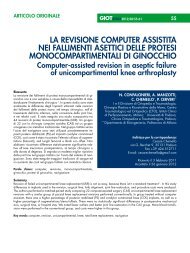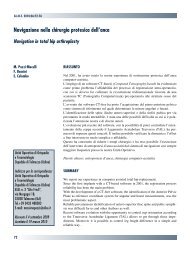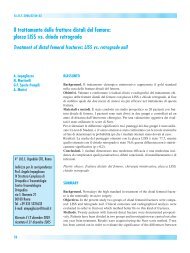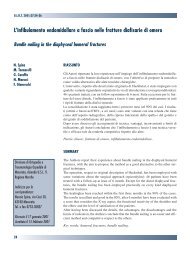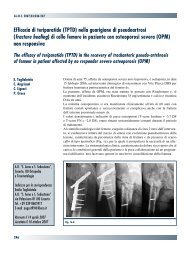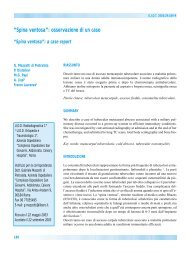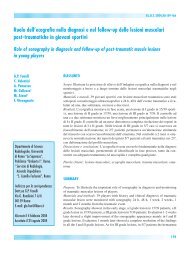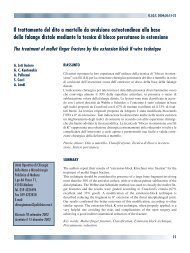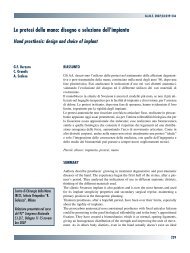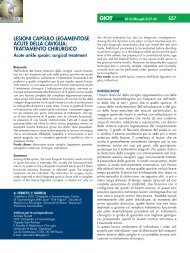30845 Suppl Giot.pdf - Giornale Italiano di Ortopedia e Traumatologia
30845 Suppl Giot.pdf - Giornale Italiano di Ortopedia e Traumatologia
30845 Suppl Giot.pdf - Giornale Italiano di Ortopedia e Traumatologia
You also want an ePaper? Increase the reach of your titles
YUMPU automatically turns print PDFs into web optimized ePapers that Google loves.
Biomateriali e biotecnologie in chirurgia ortope<strong>di</strong>ca: spalla e gomito<br />
Fig. 1. Fase operatoria <strong>di</strong> impianto della componente<br />
omerale in TMT.<br />
S250<br />
anche nelle fratture scomposte<br />
pluriframmentarie<br />
dell’omero prossimale, per<br />
promuovere la osteointegrazione<br />
delle tuberosità<br />
anatomicamente ricostruite<br />
sullo stelo rivestito <strong>di</strong><br />
tantalio. Il riscontro clinico<br />
e ra<strong>di</strong>ografico che<br />
la componente glenoidea<br />
costituisce l’anello debole<br />
della protesi <strong>di</strong> spalla 19 ,<br />
ha portato ad estendere la tecnologia TMT anche alla glenoide (Fig.<br />
2). Le proprietà osteoinduttive del mantello in tantalio trabecolare<br />
favoriscono la neovascolarizzazione permettendo la formazione <strong>di</strong><br />
osso e la sua permanenza nel tempo 20 . Il confronto <strong>di</strong> glenoi<strong>di</strong> in<br />
TMT con glenoi<strong>di</strong> cementate in polietilene, evidenzia una maggiore<br />
stabilità del TMT quando sottoposto a carichi ciclici 21 , che è apparso<br />
anche più flessibile nel <strong>di</strong>stribuire le forze <strong>di</strong> contatto. All’analisi con<br />
elementi finiti, lo stress da contatto delle glenoi<strong>di</strong> in TMT è risultato<br />
equivalente o più basso <strong>di</strong> una glenoide solida in metal-back 21 .<br />
arTrOPLaSTICa DI GOMITO<br />
Le protesi vincolate rappresentano<br />
il gold standard nei casi<br />
<strong>di</strong> significativo deficit osseo,<br />
avanzata deformità, grave instabilità<br />
o insufficienza legamentosa.<br />
Attualmente, tutttavia,<br />
sono <strong>di</strong>sponibili sistemi protesici<br />
semivincolati che possono<br />
rappresentare una favorevole<br />
alternativa per i pazienti giovani.<br />
La decisione <strong>di</strong> protesizzare il<br />
capitello ra<strong>di</strong>ale o <strong>di</strong> lasciarlo in<br />
sede è basato sulla valutazione<br />
intraoperatoria delle con<strong>di</strong>zioni<br />
dell’articolazione omero-ra<strong>di</strong>ale. In tal caso si può scegliere <strong>di</strong> impiantare<br />
una protesi bipolare <strong>di</strong> capitello insieme ad una componente<br />
omerale modellata per accogliere la protesi ra<strong>di</strong>ale. Gli attuali sistemi<br />
protesici convertibili offrono la possibilità <strong>di</strong> impiantare un’artroplastica<br />
vincolata per avere una iniziale stabilità che permetta una mobilizzazione<br />
precoce con successiva conversione a protesi non vincolate<br />
dopo completa guarigione delle strutture legamentose ricostruite.<br />
OSTEOSINTESI DELL’OMErO PrOSSIMaLE<br />
Fig. 1. Fase operatoria <strong>di</strong> impianto della componente<br />
omerale in TMT.<br />
Non esistono stu<strong>di</strong> che supportano in modo efficace la scelta del<br />
trattamento più opportuno per le fratture dell’omero prossimale 22 .<br />
Le fratture a 2 frammenti vengono sovente trattate con sintesi endomidollare<br />
per il minor tasso <strong>di</strong> complicanze rispetto all’osteosintesi<br />
con placche, che invece da migliori risultati nelle fratture a 3 frammenti.<br />
Nelle fratture a 4 frammenti è spesso necessario l’impianto<br />
<strong>di</strong> una protesi omerale. I materiali utilizzati per le moderne placche<br />
sono l’acciaio e il titanio, quest’ultimo molto elastico e facilmente<br />
modellabile. Per la fissazione si utilizzano <strong>di</strong> preferenza viti degli<br />
stessi materiali anche se recenti stu<strong>di</strong> <strong>di</strong> biomeccanica non mostrano<br />
<strong>di</strong>fferenze significative nella tenuta tra viti da spugnosa semifilettate<br />
e pegs completamente lisci 23 .<br />
BIBLIOGraFIa<br />
1 Ratner BD. Biomaterials science: an introduction to material in me<strong>di</strong>cine.<br />
2nd ed. Boston: Elsevier Academic Press; 2004.<br />
2 Badylak SF. The extracellular matrix as a biologic scaffold material.<br />
Biomaterials 2007;28:3587-93.<br />
3 Valentin JE, Badylak JS, McCabe GP, et al. Extracellular matrix bioscaffold<br />
for orthopae<strong>di</strong>c application: a comparative histologic study. J Bone Joint<br />
Surg Am 2006;88:2673-86.<br />
4 Merolla G, Campi F, Pala<strong>di</strong>ni P, et al. Efficacy of anatomical prostheses in<br />
primary glenohumeral osteoarthritis. Chir Organi Mov 2008;91:109-15.<br />
5 Huguet D, DeClerq G, Rio B, et al. Results of a new stemless shoulder<br />
prostheses: ra<strong>di</strong>ologic proof of maintained fixation and stability after<br />
a minimum of three years follow-up. J Shoulder Elbow Surg 2010;<br />
doi:10.1016/j.jse.2009.12.009.<br />
6 Gramstad GD, King GJW, O’Driscoll SW, et al. Elbow arthroplasty using<br />
a convertible implant. Tech Hand Upp Extr Surg 2005;9:153-63.<br />
7 Levine BR, Sporer S, Poggie RA, et al. Experimental and clinical<br />
performance of porous tantalum in orthope<strong>di</strong>c surgery. Biomaterials<br />
2006;27:4671-81.<br />
8 Chu<strong>di</strong>k SC, Weinhold P, Dahners LE. Fixed-angle plate fixation in<br />
simulated fractures of the proximal humerus: abiomechanical study of a<br />
new device. J Shoulder Elbow Surg 2003;12:578-88.<br />
9 Edwards Sl, Wilson NA, Zhang LQ, et al. Two-part surgical neck fractures<br />
of the proximal part of the humerus. A biomechanical evaluation of two<br />
fixation techniques. J Bone Joint Surg Am 2006;88:2258-64.<br />
10 Lo IK, Burkhart SS. Arthroscopic revision of failed rotator cuff repairs:<br />
technique and results. Arthroscopy 2004;20:250-67.<br />
11 Galatz LM, Ball CM, Teefey SA, et al. The outcome and repair integrity of<br />
completely arthroscopically repaired large and massive rotator cuff tears. J<br />
Bone Joint Surg Am. 2004;86:219-24.<br />
12 Burkhart SS, Danaceau SM, Pearce CE. Arthroscopic rotator cuff repair:<br />
analysis of results by tear size and by repair technique-margin convergence<br />
versus <strong>di</strong>rect tendon-to-bone repair. Arthroscopy 2001;17:905-12<br />
13 Davidson PA, Rivenburgh DW. Rotator cuff repair tension as a determinant<br />
of functional outcome. J Shoulder Elbow Surg 2000;9:502-6.<br />
14 Wong I, Burns J, Snyder S. Arthroscopic Graft-Jacket repair of rotator cuff<br />
tears. J Shoulder Elbow Surg 2010;19:104-9.<br />
15 Iannotti JP, Codsi MJ, Kwon Y W, et al. Porcine submucosa augmentation<br />
of surgical repair of chronic two tendon of rotator cuff tears. J Bone Joint<br />
Surg Am 2006;88:1238-44.<br />
16 Rodeo SA, Potter HJ, Kawamura S, et al. Biologic augmantation of rotator<br />
cuff tendon-healing with use of mixture of osteoinductive growth factors. J<br />
Bone Joint Surg Am 2007;89:2485-97.<br />
17 Zhang Y, Ahn PB, Fitzpatrick DC, et al. Interfacial frictional behavior:<br />
cancellous bone, cortical bone, and a novel porous tantalum biomaterial”.<br />
J Musculoskelet Res 1999;3:245-51.<br />
18 Levine B. A new era in porous metals: applications in orthopae<strong>di</strong>cs.<br />
Advanced Engineering Materials 2008;10:788-92.<br />
19 Merolla G, Campi F, Pala<strong>di</strong>ni P, et al. Correlation between ra<strong>di</strong>ographic<br />
risk for glenoid component loosening and clinical scores in shoulder<br />
arthroplasty. Chir Organi Mov 2009;S29-34.<br />
20 Karageorgion V, Kablan D. Porosity of 3D biomaterial scaffolds and<br />
osteogenesis. Biomaterials 2005;26:5474-91.<br />
21 Mroczkowski, M. Performance evaluation of the trabecular metal glenoid.<br />
http://www.zimmer.com/ctltemplate=MP&op=global&action=1&id=1052<br />
4. Accessed 2010 April 28.<br />
22 Lanting B MacDermid J, Drosdowech D, et al. Proximal humeral fractures: a<br />
systematic of treatment modalities. J Shoulder Elbow Surg 2008;17:42-54.<br />
23 Schumer RA, Muckley KL, Markert RJ, et al. Biomechanical comparison<br />
of a proximal humeral locking plate using two methods of head fixation. J<br />
Shoulder Elbow Surg 2010;doi:10.1016/j.jse.2009.11.003.



